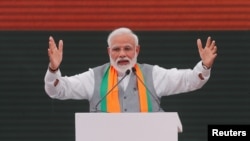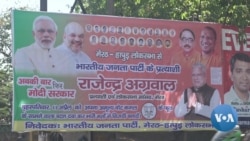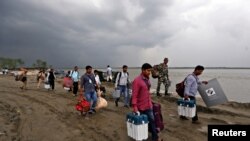India’s mammoth, multi stage election gets underway Thursday with Prime Minister Narendra Modi pitching himself as a strong nationalist leader as he seeks a second term in office from the world’s biggest electorate while the opposition Congress Party woos poor voters with a new welfare measure.
Modi’s Hindu nationalist Bharatiya Janata Party hopes that a wave of nationalist sentiment that swept the country following a recent confrontation with archrival Pakistan will reverse the slide it witnessed just months ago when it lost three strongholds in local polls.
It is promising income and pension schemes for farmers as a faltering rural economy and high unemployment disillusion many voters who feel that Modi’s 2014 promise to create millions of new jobs and usher in far-reaching change never came to pass. But although the Prime Minister’s popularity has receded, it is still higher than that of his main opponent, Rahul Gandhi, according to opinion polls.
Focus on national security
Analysts say the focus on national security appears to be trumping over bread and butter issues. “There would be a strong segment who would go with the BJP because of belief in the leadership of the party, another which would go with it because of its ideology and a third group which would go with the BJP simply because they believe there is no alternative,” says Sandeep Shastri, vice chancellor of Jain University.
The opposition Congress Party, headed by Rahul Gandhi, the fifth generation of the famous Nehru-Gandhi family that ruled India for many decades, is hoping to reemerge as a political force after plummeting to its lowest ever tally in parliament in 2014.
It is optimistic that an ambitious poll promise to ensure an annual basic income of $ 1010 to India’s poorest households will be a “game changer” and win back the millions who deserted the party five years ago. The Congress Party’s hopes to unseat Modi have risen after it wrested three states from the BJP but according to analyst Shastri the party’s shrinking support base poses a challenge.
WATCH: Can Modi Win Key Battleground State?
Strength of India's regional parties
An array of powerful regional parties that play a key role when the two mainstream parties fail to win a parliamentary majority could also influence the outcome. These parties, which have strong bases in several of India’s 29 states like West Bengal, Uttar Pradesh and Bihar, have said they will put together an alliance to challenge Modi if he does not win enough votes. In the battleground state of Uttar Pradesh for example, where the BJP’s swept 71 out of 80 seats in 2014, two regional parties that have strong support among Muslims and low castes, have teamed-up to give him a much tougher contest.
Anticipating loss of support in populous, Hindi heartland states that are home to its core supporters, the BJP has stitched alliances with some regional parties to make up the numbers if it falls short of a majority.
The BJP’s hopes of winning are pinned on the prime minister’s image, who on the campaign trail has been calling himself “India’s chowkidar" (watchman). “If Modi is there, it is possible,” is the party’s campaign slogan.
A decision on PM Modi
On the streets, many want to give him another chance. “He has brought development to my village, toilets, roads and electricity,” says Babloo Singh, who works as a construction contractor in New Delhi.
“I think the 2019 election is a lot about Narendra Modi himself. He is at the heart of it, those for him and those against him,” says New Delhi based political analyst Neerja Chowdhury. “As far as the opposition is concerned, they are targeting him for the erosion in freedoms that have taken place under him but highlighting the burning issue that is joblessness and rural distress.”
The campaigns of Prime Minister Modi and his main opponent Congress Party head Rahul Gandhi have witnessed some of the sharpest attacks on each other witnessed in Indian elections. The BJP accuses the Congress, which ruled the country for many years since independence, of “playing with national security” and holding back its progress for decades. The Congress party accuses the Prime Minister of posing a threat to the country’s secular fabric by pushing a Hindu nationalist agenda.
Concerns that polarization has deepened during the rule of the Hindu nationalist BJP are also weighing with many voters including minority communities.
The party’s agenda of protecting the cow that Hindus consider holy has led to rising incidents of violence involving cow vigilante groups who target Muslims suspected of trading in cows for slaughter.
A long complicated process
In Uttar Pradesh state, which has a large Muslim population, an employee of a food delivery firm, Mujahid Mansoori says “We need food on our table for our family. We need jobs. We don’t want anything to do with a polarized environment that is being created.”
Opinion polls have forecast that along with its allies, the BJP could win a slim majority though fall short of the numbers they secured in 2014 when for the first time in 30 years they cruised well past the half way mark in parliament. But India’s elections are hard to predict and polls have proven wrong in the past.
Who will take control of the world’s largest democracy will only be known six weeks later on May 23rd when votes are counted after seven rounds of polling for the 543 elected seats of parliament that are up for grabs.
The phased polling makes it easier to move security forces around in a gigantic election that involves nearly 900 million voters, about four million polling personnel and over a million polling booths spread from the high Himalayan slopes to deep forests and distant islands in the Bay of Bengal. In one of the world’s youngest countries, nearly 85 million of them are first time voters.
















